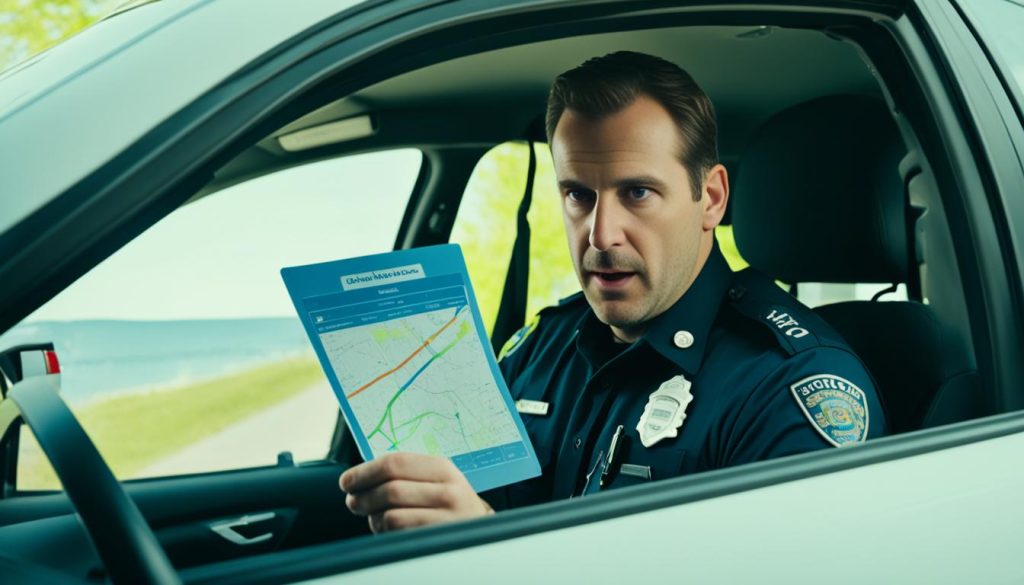Did you know that Automated License Plate Recognition (ALPR) cameras in Ontario can scan and detect thousands of license plates per hour? These cameras are used by the police to identify vehicles with plates in poor standing, such as those belonging to suspended drivers, stolen cars, or vehicles with expired validation tags. When a license plate on the “hot list” is detected, it produces a hit, alerting the officers in the cruiser and providing them with essential information about the vehicle and the registered owner.
ALPR technology has revolutionized the way police run plates, allowing for faster and more efficient enforcement. In this article, we will explore how ALPR works in Ontario, the privacy considerations surrounding its use, the impact it has on driving records, and the expansion of this technology across the province.
Key Takeaways:
- The ALPR cameras in Ontario scan and detect thousands of license plates per hour.
- Police use ALPR technology to identify vehicles with plates in poor standing, such as those belonging to suspended drivers, stolen cars, or vehicles with expired validation tags.
- ALPR technology improves efficiency and effectiveness in identifying and enforcing violations.
- The use of ALPR technology is expanding across Ontario, demonstrating the commitment to enhance public safety.
- Privacy considerations and compliance with privacy laws are taken into account when using ALPR systems.
How ALPR Works in Ontario
In Ontario, ALPR cameras are mounted on the windshield of police cruisers and continuously scan license plates as the officer drives around the city. The officer is notified when there is a hit, indicating that the scanned license plate matches a plate on the hotlist. The officer must then stop the vehicle and verify all information before taking any enforcement action.
Police officers have access to an Ontario Ministry of Transportation and Canadian Police Information Centre hotlist, which contains millions of license plates in poor standing. The ALPR system does not give police access to any new information; it simply automates the process of running license plates and checking for violations.
With ALPR technology, police officers can efficiently and accurately identify vehicles with plates in poor standing, such as those belonging to drivers with suspended licenses, stolen vehicles, or vehicles with expired validation tags. By automating the process of scanning license plates and cross-referencing them with the hotlist, ALPR technology helps enhance law enforcement efforts and improve road safety in Ontario.

| ALPR Technology Benefits in Ontario | ALPR Technology Limitations in Ontario |
|---|---|
|
|
Privacy Considerations with ALPR in Ontario
The use of Automated License Plate Recognition (ALPR) technology by police services in Ontario is subject to regulations and guidelines to ensure the protection of citizens’ privacy rights. The Information and Privacy Commissioner of Ontario has released guidelines in accordance with the Canadian Charter of Rights and Freedoms, ensuring that the use of ALPR systems is compliant with established privacy laws.
When it comes to the handling of information obtained from the ALPR program, police services in Ontario adhere to the Municipal Freedom of Information and Protection of Privacy Act. This act governs the collection, retention, and disposal of personal information obtained through ALPR technology.
It’s important to note that the ALPR system does not store information related to non-hits, meaning that data for vehicles without any violations is not retained. However, information related to hits is retained in accordance with privacy laws, ensuring that legal requirements are met.
If you have any questions or concerns about the use of ALPR technology or the handling of your personal information, it is advised to reach out to the appropriate police department to seek clarification and obtain further details.
Impact of ALPR on Driving Records in Ontario
The Automated License Plate Recognition (ALPR) system in Ontario plays a crucial role in identifying vehicles with plates in poor standing. This includes vehicles owned by individuals with suspended licenses, stolen cars, or vehicles with expired validation tags. When a hit occurs, police officers take appropriate enforcement action, which can involve issuing tickets or arresting individuals with outstanding warrants.
One of the common violations related to license plate status is having expired plates. In Ontario, driving with expired plates can result in fines and other penalties. It is essential for vehicle owners to ensure that their plates are up to date and comply with registration requirements to avoid any potential issues.
By using ALPR technology, law enforcement agencies in Ontario can efficiently detect and address violations, ultimately improving road safety. The system streamlines the process of identifying vehicles with plates in poor standing, allowing police officers to focus on other critical aspects of their duties.
The Impact of ALPR on Driving Records
The ALPR system offers several benefits when it comes to maintaining accurate driving records in Ontario:
- Efficiency: ALPR cameras can scan thousands of license plates per hour, significantly speeding up the process of identifying vehicles with plates in poor standing.
- Accuracy: ALPR technology eliminates human error and ensures the accurate identification of vehicles with violations, minimizing the risk of false positive or false negative results.
- Enforcement: When a hit occurs, police officers can take prompt enforcement action, reducing the chances of repeat offenses and promoting compliance with driving regulations.
Overall, the ALPR system has a significant impact on driving records in Ontario, helping to maintain safer roads and ensuring that vehicles are in compliance with the law.

Expansion of ALPR Technology in Ontario
As technology continues to advance, the use of Automated License Plate Recognition (ALPR) systems is expanding in Ontario. More police cruisers are being equipped with ALPR cameras, allowing for a more efficient and effective identification of vehicles with plates in poor standing. This expansion is an important step towards enhancing road safety and improving enforcement efforts in the province.
With ALPR technology, the process of scanning license plates and checking for violations is automated. This means that police officers can now focus more on other aspects of their duties, such as engaging with the community and responding to emergencies, while still maintaining effective enforcement. ALPR technology has proven to be a valuable tool in enhancing public safety and reducing the burden on law enforcement personnel.
The commitment of law enforcement agencies in Ontario to utilize innovative technologies like ALPR systems showcases their dedication to ensuring the safety of the public. By harnessing the power of ALPR technology, police officers can promptly identify vehicles with plates in poor standing, such as those belonging to suspended drivers or stolen cars. This proactive approach helps prevent potential risks on the road and contributes to a safer environment for everyone.
The expansion of ALPR technology is a significant development for law enforcement in Ontario. By embracing these advancements, police agencies are taking a proactive stance in ensuring the well-being of their communities. The use of ALPR systems demonstrates their commitment to utilizing cutting-edge tools for effective enforcement and improved public safety across the province.